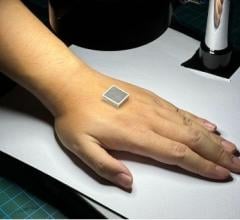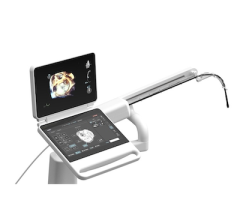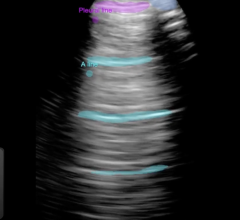Numerous clinical data and physician-led presentations during the TCT meeting in October addressed the important role IVUS can play as part of every day interventional procedures. Topics of these presentations included current IVUS applications related to optimal drug-eluting stent (DES) sizing and placement, post-DES confirmation of expansion and apposition, and the ability of Volcano Corp.’s proprietary VH IVUS technology to identify plaque composition, and in turn help identify angiographically silent or intermediate lesions potentially at risk for a future coronary event.
"We had a very strong presence at the recent TCT meeting, where there was a great deal of discussion surrounding the role of IVUS in placement of bare-metal and drug-eluting stents,” said Scott Huennekens, president and CEO of Volcano Corp. “Many physicians believe that IVUS can help ensure proper stent expansion and apposition. Furthermore, using angiography alone, it is often impossible to determine where a lesion begins and ends. IVUS provides information regarding lesion morphology and location, helping physicians to more completely cover diseased tissue with stents."
Volcano-related TCT highlights included:
-- Dr. William Wijns from Aalst, Belgium presented data showing that 77 percent of DES patients reporting stent thrombosis displayed incomplete stent apposition at the time of thrombosis. This compares to patients without stent thrombosis that only had a 12 percent incidence of incomplete apposition. Dr. Wijns commented, "Based on the safety concerns of drug eluting stents with early and late stent thrombosis there are three immediate things all interventionalists should do to improve on modifiable risk factors. First is case selection that includes individualized evaluation of benefit and risk, second is optimization of implantation technique in order to reduce early stent thrombosis including the use of IVUS, and third is ensure patient compliance with dual, anti-platelet therapy."
-- Dr. Marco Costa from the University of Florida presented the STLLR
study results, a double blinded, prospective multi-center trial of
1,419 patients. The data demonstrated that geographic miss occurs in
66.5percent of DES procedures using only angiographic guidance, which also
correlated with higher target vessel revascularization and myocardial
infarction.
-- Dr. Renu Virmani, a leading cardiovascular pathologist, presented
autopsy data which identified the five primary causes of late stent
thrombosis. These included discontinuation of anti-platelet therapy,
stent mal-apposition, stent struts imbedded in necrotic core,
hypersensitivity reaction to the implant, and ostial or bifurcation
stenting.
-- Dr. Gregg Stone presented a clinical update on the initial 250 patients
in the landmark PROSPECT natural history trial, including baseline
demographic data and imaging examples. PROSPECT is a 700 patient U.S.
and European study being sponsored by Abbott Vascular (formerly the
vascular business of Guidant Corporation) and Volcano, and is designed
to study the progression of plaque in patients suffering from acute
coronary syndrome. The initial findings were presented by Dr. Stone,
and included that three-vessel VH IVUS imaging is feasible in a
clinical setting. The interim data also showed that on average, 2.5
angiographically visible but "mild" (diameter stenosis
are left untreated, and that 16percent of these lesions are in fact severe by
quantitative coronary angiography (diameter stenosis > 50 percent), and met
current guidelines for interventional or surgical intervention. By
IVUS, the total number of identified lesions was 2.9 per patient in the
proximal and mid coronary tree, of which 25percent are classified as severe
by IVUS. Using VH IVUS, Dr. Stone and colleagues were able to identify
lesions with presumed characteristics of vulnerable plaque in 35 percent of
patients, which remain untreated as part of the PROSPECT trial design.
This data (after follow-up) may allow physicians to more accurately
triage intermediate lesions, and be used to assess appropriate
interventional or systemic treatment for atherosclerotic disease. This
interim data is also consistent with recent findings in autopsy
specimens of sudden coronary death. Dr. Stone commented, "As the first
prospective natural history study examining whether novel blood and
imaging tests are able to identify patients at risk for future death
and heart attack, PROSPECT promises to provide groundbreaking data
critical to understanding the progression of coronary artery disease,
and represents the first step toward identifying patients at high risk
who may benefit from preventative therapies."
-- Interim Data from the Volcano sponsored VH Registry was presented as
part of six separate abstracts correlating VH IVUS tissue
characterization data to baseline patient demographics, clinical
presentation, and cardiac risk factors. The initial data presented at
TCT was taken from the first 990 worldwide patients (of the more than
3,000 patients currently enrolled). Some initial findings from this
data demonstrated important correlations:
- Men have more plaque volume than women;
- Male plaque composition consists of higher fibrous and fibro-fatty
content;
- With age, the amount of dense calcium and necrotic core increases
significantly, especially in women post menopause;
- Patients with prior cardiac history, myocardial infarction, previous
coronary bypass and diabetes have an increased amount of both dense
calcium and necrotic core;
- Patients with ischemia do not have an increased plaque burden, but
rather a difference in composition of the plaque; and
- Finally, data showed that a combination of aspirin and statin therapy
correlated with less plaque burden, and less fibrous and fibro-fatty
plaque, suggesting the effectiveness of systemic therapy may be
measured by both amount and composition of plaque.
Scott Huennekens continued, "The VH Registry will provide the
cardiology community with a robust dataset to correlate baseline
patient demographic information with VH IVUS tissue characterization.
This early data seems to suggest that known cardiac risk factors do
in fact support increased necrotic content, which is consistent with
autopsy findings of sudden coronary death victims. We believe this
further validates our technology, and feasibility as a more precise
diagnostic tool."
-- Dr. Uwe Siebert, director of the Cardiovascular Research Program at the
Institute for Technology Assessment at Massachusetts General in Boston
presented a cost-benefit analysis of a catheter-based diagnostic for
the identification of vulnerable plaque. His conclusions were that a
catheter-based approach in conjunction with stenting may be cost-
effective across a wide range of parameters.
-- Various presentations by physicians, including Dr. Gary Mintz, Dr. John
Hodgson and Dr. Peter Fitzgerald summarized the growing body of IVUS
guided stenting data that concludes;
- Stent under-expansion (MSA
majority of sirolimus-eluting-stent (SES) restenosis.
- In vivo VH(TM) IVUS analysis indicates that stent under-expansion
most often occurs at the site of increased amounts of dense calcium
and larger plaque burden.
- The potential role of IVUS in DES placement is to determine stent
size from reference lumen diameter, determine stent expansion based
on lumen area, detect peri-stent problems like edge tears, and to
assess the effect of calcium on stent expansion.
Dr. Gary Mintz commented that, "There is considerable data supporting the value of IVUS to optimize implantation of bare metal stents. There is no reason to believe that the same IVUS guided technique would not benefit drug eluting stents as well."
As displayed at the TCT 2006, data suggests the Volcano's IVUS technology has a role in both optimization of stenting in everyday PCI, and in clarifying the atherosclerotic disease process and guiding more targeted interventional and systemic therapies, even in patients with angiographically "normal" or intermediate disease.
About Volcano Corporation
Volcano Corporation, which completed its IPO in June 2006, offers a broad suite of devices that facilitate endovascular procedures, enhance the diagnosis of vascular and structural heart diseases and guide optimal therapies. The company's intravascular ultrasound (IVUS) product line includes ultrasound consoles that can be integrated directly into virtually any modern cath lab and single-use phased array and rotational IVUS imaging catheters. Volcano also has unique advanced functionality options like VH tissue characterization and IVUS and angiography co-registration. Volcano also provides functional measurement (FM) consoles and single-use pressure and flow guide wires. Currently, more than 2,300 Volcano IVUS and FM systems are installed worldwide, with approximately half of its revenues coming from outside the United States. For more information, visit the company's website at www.volcanocorp.com .
This press release contains forward-looking statements within the meaning of the U.S. Private Securities Litigation Reform Act of 1995. Statements in this press release regarding Volcano's business that are not historical facts may be "forward-looking statements" that involve risks and uncertainties. Specifically statements regarding the introduction and commercialization of new products, shortened procedure time, ease of product use, the availability or results of clinical trial activities, the performance of the company's IVUS systems and customer acceptance, use of the company's products and technologies, the outcome of final data relating to clinical studies, the role of IVUS technology in optimizing stent placement and the role of IVUS in clarifying atherosclerotic disease process and guiding interventional and system therapies are forward-looking statements that involve risks and uncertainties. Forward-looking statements are based on management's current, preliminary expectations and are subject to risks and uncertainties, which may cause Volcano's results to differ materially from the statements contained herein. The potential risks and uncertainties that could cause actual results to differ from the results presented are detailed in the company's 10-Q and other filings made with the Securities and Exchange Commission. Undue reliance should not be placed on forward-looking statements, which speak only as of the date they are made. Volcano undertakes no obligation to update publicly any forward-looking statements to reflect new information, events or circumstances after the date they are made, or to reflect the occurrence of unanticipated events.


 December 10, 2025
December 10, 2025 









